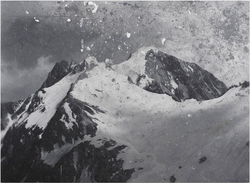 Rudolf Stingel, untitled, 2010
Rudolf Stingel, untitled, 2010 Last spring, I had the great luck to see Rudolf Stingel's exhibition at Gagosian Gallery in the Chelsea area of New York. Walking into the huge gallery was literally a breathtaking experience. On each of the four walls was one immense painting up to fifteen feet across of the Tyrolean Alps of Stingel's native Merano, Italy. More specifically, they were paintings of vintage and time-worn photographs or photographs printed from time-worn negatives. Because of the varied conditions of the supposed source, the five paintings of the exhibition (there was one smaller work in a side gallery) presented varying degrees of abstraction: one might have been titled "Mountains in a Blinding Blizzard".
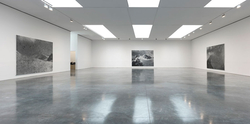 Rudolf Stingel, installation view
Rudolf Stingel, installation view I was unfamiliar with Stingel's work but I became an immediate acolyte. The paintings are overwhelming and awe-inducing in scale, subject, and application and, most remarkably, as viewed from any distance. Whether seen from 100 feet away or right on top of them or any space in between, the paintings are both challenging and satisfying but always different, based on one's viewpoint. From afar, the toughness of the photorealistic precision is paramount while, closer up, the painterly intimacy is palpable. In between,they take the viewer to someplace otherworldly and exhilarating. Hence, they become the perfect paintings: always responding to the interaction of the viewer with expanding content.
The viewer can't help but question and, therefore, become engaged with the process, further marrying the tenets of photorealism and action painting. I was excited to deduce that Stingel paints them "down" as we do scenery at the MUNY: canvas on the floor with the artist working on top. I spotted at least two footprints.
The viewer can't help but question and, therefore, become engaged with the process, further marrying the tenets of photorealism and action painting. I was excited to deduce that Stingel paints them "down" as we do scenery at the MUNY: canvas on the floor with the artist working on top. I spotted at least two footprints.
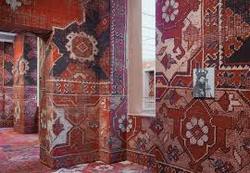 Rudolf Stingel, Palazzo Grassi, 2013
Rudolf Stingel, Palazzo Grassi, 2013 Besides the over-sized photorealism, Stingel's oeuvre seems to be very eclectic and I haven't seen enough of it yet. A fascinating piece is his 2013 installation in the Palazzo Grassi Gallery in Venice, Italy, where he covered most public surfaces of the gallery with synthetic oriental carpet designs on which he judiciously hung abstract and photorealist grisaille oil paintings.
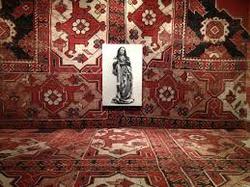
When reviewing that installation, Roberta Smith of the New York Times wrote, "Mr. Stingel is among the great anti-painting painters of our age, a descendant of Warhol but much more involved with painting’s conventions and processes, which he alternately spurns, embraces, parodies or exaggerates. His art asks what are paintings, who makes them, and how?"1
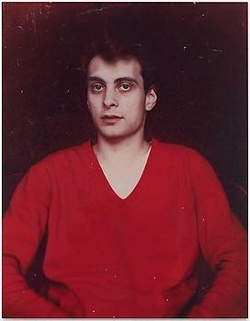 Rudolf Stingel, untitled, 2010
Rudolf Stingel, untitled, 2010 I'm an art book and exhibition catalogue junkie and Gagosian offers a Stingel catalogue but I've resisted buying it: not because of the $80 price tag, but because of the anticipated disappointment. It is a testament to the purity of Stingel's painting that seeing them in reproduction does not appeal to me. The painting on the left is 131"x102". It is an arresting image in reproduction but I'm sure that what we see here is only a fraction of the aesthetic experience of seeing it in person: to view it not as the creator intended is to be deprived of the creator's aesthetic intent.
That notion is true of all art, of course, but, in this digital age when the lines of visual truth are constantly being blurred, it is refreshing and reaffirming to see art, and specifically painting, that cannot and will not accommodate the capriciousness of technology.
1. Roberta Smith, "The Threads That Tie a Show Together: Rudolf Stingel's Carpeting Makeover in Venice", The New York Times, August 20, 2013 <www.nytimes.com/2013/08/21/arts/design/rudolf-stingels-carpeting-makeover-in-venice.html?pagewanted=all&_r=0>.
That notion is true of all art, of course, but, in this digital age when the lines of visual truth are constantly being blurred, it is refreshing and reaffirming to see art, and specifically painting, that cannot and will not accommodate the capriciousness of technology.
1. Roberta Smith, "The Threads That Tie a Show Together: Rudolf Stingel's Carpeting Makeover in Venice", The New York Times, August 20, 2013 <www.nytimes.com/2013/08/21/arts/design/rudolf-stingels-carpeting-makeover-in-venice.html?pagewanted=all&_r=0>.